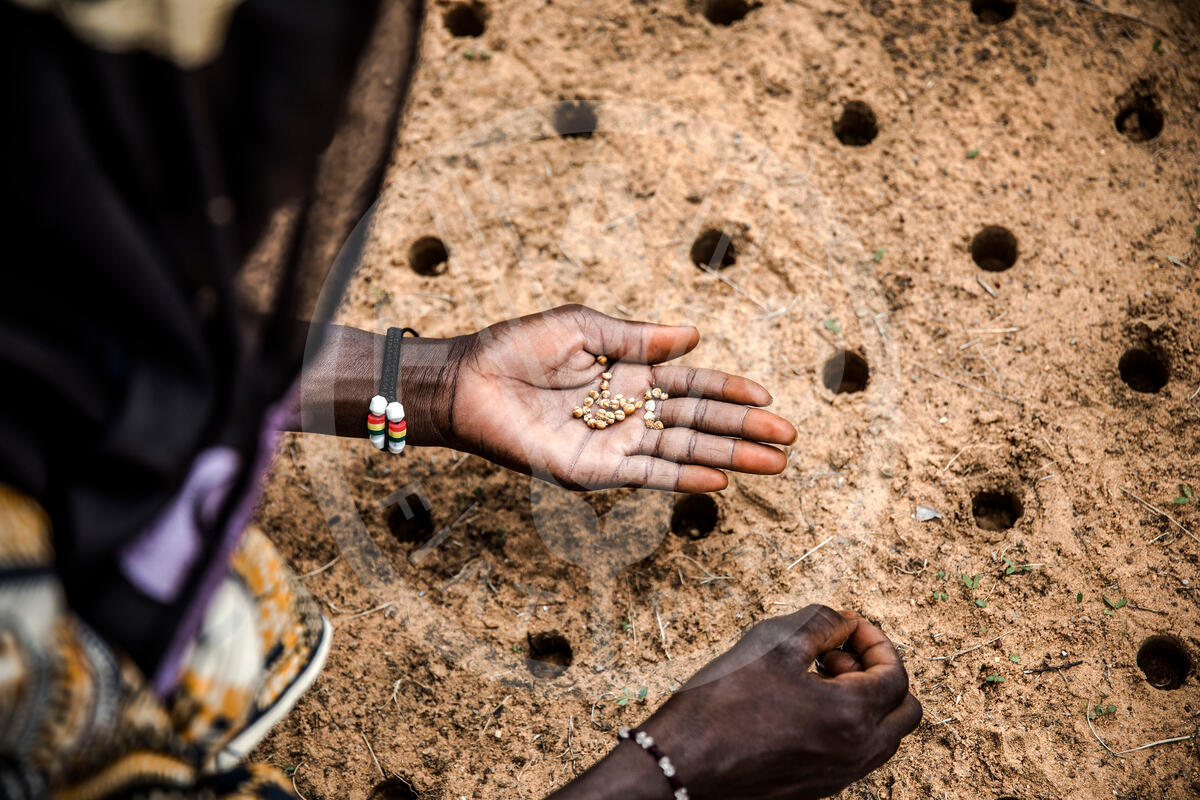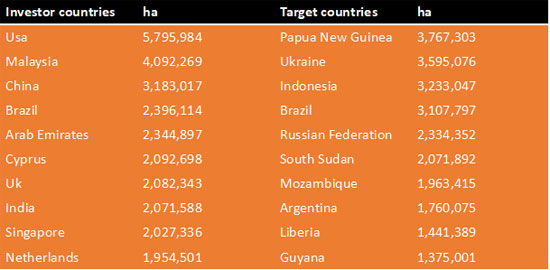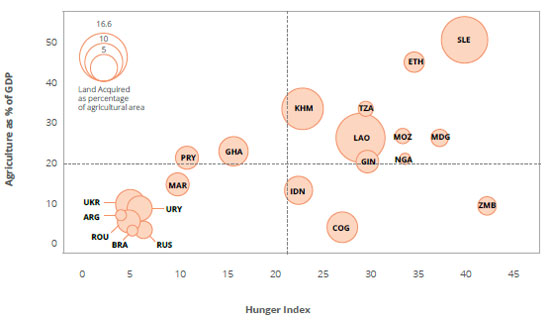Land grabbing: what does it truly mean?

Land grabbing is a term that is getting higher attention in the mainstream debates (articles, conferences, media), but what does it truly mean? Why should we be concerned about it?
The term land grabbing refers to the widespread large-scale acquisitions or leases of land and land-related rights that is currently taking place in the Global South, driven by foreign governments and private corporations. So far, more than 68 million ha of land have been acquired all over the world establishing a global process of privatization and commodification of land and natural resources. However, what truly characterized these kind of land deals is the total exclusion of the local population that lives in these areas.
Normally, the affected communities are not updated neither about the terms of the contract, nor about the future business plan concerning their land, and if a remuneration is expected. They don’t even know that their land is going to be sold; in fact, usually they find out about the conclusion of the contract when the eviction notice arrives. In the best case, they will be relocated in camps or ‘similar’ territories receiving a little amount of money as reparation that will never substitute the loss of their houses, cultural heritage, traditions, and of their unique mean of subsistence, wholly represented by their land. Moreover, these affairs are carried out without a clear assessment about the possible implications on the local context, in terms of labour, economic benefits, social relations and environmental impact; thus, leaving the burden of the collateral effects on the locals.
This trading manner is possible due to weak land governance regimes and to the lack of regulations over agriculture investments that are typical in the countries that host land grabbing projects.
Commonly, these legal systems do not recognize the private property regime or the land rights of indigenous communities, making smallholder farmers and rural people susceptible to corrupt land deals, expropriation and lack of fair level of compensation. The use and distribution of land is totally managed by the state authorities which are keen to undersell huge plot of domestic land with the aim to attract stable flows of foreign investments and hard currency. Therefore, the local populations are left alone to assert their self-determination and to fight for the enjoyment of their basic human rights directly interrelated with the conservation of their native land. However, they frequently ended up having only the possibility to either leaving or hoping to be absorbed into the new business in order to survive.
For understanding the underlying causes of land grabbing, we have to go back to 2007-2008, which have been crucial years for the emergence of this phenomenon. In this time period, three distinct crises, namely, food, fuel and financial, converged, leading to a new revaluation and rush for land.
During the food crisis the prices of staple food - rice, corn and wheat - increased due to multiple reasons: a series of bad harvests, chronic lack of investment in agriculture, widespread agrofuel farming, market fluctuations and financial speculation. In these circumstances of scarcity, the food-producing countries enacted a series of protectionist measures for lowering the mass of exports with the aim of safeguarding their food security, thus skyrocketing the overall prices that in turn resulted in food shortages and disorders in most countries of the Global South. In this context, the main food-importing countries like India, China, Brazil and Arab States, which have been heavily affected by price growth, launched a ‘land rush’: they started grabbing offshore land overseas in order to ensure a cheap and stable food supply bypassing the global market as a long-term strategy to achieve food security.
In the meanwhile, the financial bubble caused by the sub-prime mortgage meltdown blew up, bringing forth the most severe economic crisis of the last decades, which had direct consequences on the evolution of the food crisis.
The traditional investment sector was no longer reliable, so the financial actors started to look for secure frontiers of profit and accumulation. The commodity futures and the investments in land appeared to be the most solid and effective ones, boosting the land rush also among the big financial speculators. Thus, the financial crisis acted as spark, triggering a domino effect in the international markets: on the one hand, a crowd of speculators have focused on the acquisition of land for regain money and power; on the other hand, this new attention on agriculture has increased the overall prices of food, relapsing on the last tile the population.
A third trend that promotes the investments in land is the energy crisis. It is well-known that the deposits of fossil fuel are running out, its extensive is one of the major causes of the climate change. As consequences the oil price steadily increased, hitting the highest price between 2011-2012, affecting the food production and distribution costs, that impacted on the living costs. Clearly, there is a necessity to find out other sources of energy, which must be clean, sustainable, and renewable: agrofuels are among them. Hence, the production of biofuels and the perspective of rich and substantial profit have led to widespread investments in land by energy companies and agricultural multinationals, which often have resulted in cases of land grabbing. According to Land Matrix the agrofuels are the second among the agricultural intentions of land acquisition, occupying the 21% of the total areas acquired, which mostly are in Africa and South America.
However, the creation of this global land market, would not be possible without the direct involvement of the most prominent international agencies for development, namely: the World Bank and its International Finance Corporation (IFC), the International Monetary Funds (IMF), and all the regional development banks like the European Bank for Reconstruction and Development (EBRD), the African Development Bank (AfDB) or the Asian Development Bank (ADB). These institutions have promoted and sponsored the FDIs in land with the aim to foster development in the agricultural sector.
In this crisis narrative, the land seems to be the answer to all these present and future uncertainties. Thanks to the technological development, the land is, indeed, a resource of multiple assets such as food, water, biofuel, feed and other industrial commodities like minerals, wood, pulp, which are all resources necessary to possess for safeguarding and maintaining our standard of living. Therefore, this understanding gives the start to another cumulative process, the accumulation of land.
The main targets of land grabbing are countries rich in fertile land and natural resources: water, oil, minerals, forests etc. Most of them are located in the Global South in particular in Sub-Saharan Africa, South-east Asia, Latin America and East Europe.

A chart of the top 10 investors and target countries by Landrmatrix.
As regards the investor countries, a South-South trajectory is emerging where fast growing countries (Malaysia, China, Brazil, India) are getting increasingly involved in inward and intra-regional land grabs.
On the other hand, concerning the target countries, they are characterized by a weak legal system, lower labour standards and inadequate human rights protections, but also for their evident fragility. Most of them show democracy fragility, by sharing some common features, like: being states of freshly independence with fragile national structures; countries recently involved in civil or internal wars, political tensions or famine; nations governed by despotic regimes not interested in the population’s well-being but only in securing the necessary economic and political ties for keeping the power. Hence, for different reasons, they are fragile states in clear necessities of foreign investments, with low bargaining power, keener to undersell their land and natural resources in order to achieve economic security.
Moreover, it is evident that these processes are impacting on the poorest areas of the world, where agriculture is still the economic leading sector or the unique means of subsistence for most of the populations, as testified by the underlying chart:

Typology of land acquisition according to the Global Hunger Index 2015 and agricultural GDP (Land Matrix Report 2016).
The graph presents the top target states describing them in terms of hunger incidence and their reliance on agriculture for GDP production. According to Land Matrix, for most of them diffuse and severe malnutrition is still a reality and the wealth of the country and population itself is based on farming. Therefore, it means that in these contexts the widespread privatization and dispossession of land for development, if badly managed, can heavily affect the economy and the level of food security, making these countries even more vulnerable to hunger and multiple crisis.
However, in these countries, land grabbing projects are based on capitalized and highly technological industrial and farming practices that are totally export-oriented. These methods are not intended to create shared economic benefits from which also the local people could grow and develop. On the contrary, these projects require massive quantity of land that will not create jobs or alternative ways of living. They are simply extractive businesses aimed at outsourcing food and natural resources in order to sell cheaper outputs in the domestic and international markets.
In fact, each project is not followed by the growth and construction of manufacturing industries where the commodities can be transformed and processed, creating collateral economic activities and new jobs. According to Ben White the land grabbing can be considered as a new course of the old process of ‘Enclosure’ of land, which took place in England in the XIX century. However, where it is taking place, this new wave of enclosure is not going to be followed by a new pervasive industrial revolution like in the past and it is not going to have a significant role in the domestic GDP production in comparison to the quantity of land that is required and the consequences at the local level. Then, it is licit to wonder, what the future of the population involved will be if the governments and corporations are only interested in their land and not in the landless future of these farmers.
In these contexts, the land grabbing effects on the population are crushing ranging from forced eviction, loss of land and livelihood, food insecurity, chronic poverty, systematic persecutions and violence, migration, increased social inequalities, physical and mental illness, environmental degradation, to the disappearance of entire traditional native cultures and languages.
Due to the nonexistence of national legal norms that can protect them, the rural communities are using the international human rights law as support for claiming their rights and self-determination. However, so far, the right to land has only been coded in the UN Declaration for the Rights of Indigenous Peoples; therefore, it cannot be supporting the cause of various rural communities. Nevertheless, there is a progressive tendency to consider the access to land essential for the enjoyment of other basic human rights as the rights to: food, water, adequate living standards, work, housing, not to be subjected to inhuman and degrading treatments. Therefore, the protection of this rights indirectly safeguards the right to land.
However, the human rights defenders, rural communities and farmers organizations that are fighting land grabbing are frequently subjected to violence, ostracism isolation and criminalization for their claims and actions. Thus, resolute, effective and immediate counter actions are needed. However, those embraced so far by the international community have proved to be weak and inefficient due to a mainstream short term and profit-oriented approach – adopted both by investors and governments.
To be effective, human rights defenders should re-frame the international land debate, putting at its core the human rights and the well-being of the affected communities and their environments. In doing so, the human rights defenders should identify and pursue an alternative development paradigm. This shall lead to the adoption of an inclusive and sustainable land reforms (i.e. setting common goods at community level), that shall secure the right to food (i.e. land shall serve demand from local people in first) within a new circular economy framework (value extracted shall be equal to capital invested in the same area, balancing the capital owned by the future generations).
This would be possible only through multi-level and concerted efforts of all the actors involved, starting from the international community, the national governments, private investors and civil society.

